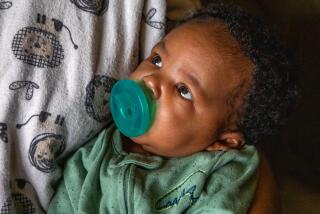An Infant-Care Lifesaver
- Share via
Federal officials report a remarkable 30% decline in sudden infant death syndrome (SIDS), which until recently took the lives of 5,000 to 6,000 babies a year. The sharp drop is attributed to a single factor: educating caregivers to put infants to sleep on their backs instead of on their stomachs. Dr. Duane Alexander, director of the National Institute of Child Health and Human Development, describes this modest change in tradition and practice as “one of the simplest and most effective public health interventions ever.” Annual SIDS-linked deaths fell by at least 1,500 between October 1993 and October 1995. Further declines are expected as more parents learn of the recommended sleeping position for babies.
Sleep position is not the only known risk factor tied to SIDS. Earlier studies also cited smoking in a room where infants sleep, rooms that are too warm and excessively soft mattresses or fluffy bedding in which a child might smother. But most SIDS cases have until recently been considered inexplicable. The absence of a known cause, of course, does nothing to assuage the grief and often the feelings of guilt felt by parents of SIDS victims.
The SIDS rate among American children up to age 1 has now declined from 1.1 per 1,000 to about 0.75 per 1,000. In Europe, Australia and New Zealand, where the SIDS rate had been much higher and where the change in sleeping position was first tried, rates have fallen by as much as half. The dramatic decline in deaths, says Alexander, is of the kind usually associated only with the introduction of a vaccine.
Surveys indicate that only 29% of American infants are now put to sleep on their stomachs; four years ago, 70% were. Can SIDS be eliminated? Probably not. But there’s every reason to believe that far fewer infants are destined to die suddenly and mysteriously, thanks to the simplest thing a caregiver can do.






